
19 Best 3D Printer Software 2023 (For Every Stage!)


At 3DSourced we’ve covered everything 3D printing and 3D since 2017. Our team has interviewed the most innovative 3D printing experts, tested and reviewed more than 20 of the most popular 3D printers and 3D scanners to give our honest recommendations, and written more than 500 3D printing guides over the last 5 years.
3D printing software programs are key for high quality printing, designing and monitoring — without software, 3D printers are just machines with no direction. 3D printer software take a variety of different forms: 3D software modeling tools to design 3D models, 3D slicers to slice STL files for printing, and specialist software for fixing errors in your models.
To make things easier for you, we have split each of these types of 3D printer software into sections. Within each section we have free 3D printing software options, as well as premium, paid options.
What makes good 3D printing software?
While we include a range of very different 3D printing software designed to address very different needs, there are some key aspects that make or break software for your 3D printer.
- Wide range of tools: we picked 3D printing software with a versatile toolset.
- Team-friendly: the best tools ideally let you collaborate with your friends, team and co-workers — especially in design software.
- Versatile: beyond the range of tools available, being able to work with a range of file types beyond just STL makes life much easier. For example, GCode, OBJ, DXF files and many other types that are commonly used.
- Save you money and time: a good example is simulation features in the most premium 3D printer design software that can simulate and analyze your model to identify areas likely to break or snap under strain, as well as any parts that are likely to warp or come out badly from printing unless supports are used.
Which is the best 3D printing software?
This is difficult to answer because there are simply so many different types of 3D printing software. These range from slicers, to 3D printer design software, to software for managing many 3D printers at once. Our ranking therefore covers:
- Part 1: 3D printer design software: including both CAD software for 3D printing, and 3D modeling software for 3D printing.
- Part 2: Sites to download 3D printer files: not technically software but still useful for those who do not want to design their own models.
- Part 3: 3D printer slicer software: for slicing models to print.
- Part 4: 3D printing software tools for fixing errors in your models and optimizing prints
- Part 5: 3D printing host software for remote monitoring and printing
Overall, we recommend almost 20 different 3D printing software options to maximize your 3D printing experience. We also include links to download each software, and a short description of the main advantages of each tool we recommend.
The Best 3D Printer Design Software
For any budding 3D designers, we recommend some 3D CAD design modeling tools for 3D printing below. We have sorted them from most beginner-friendly to most advanced, and included several free 3D printer design software.
1 – TinkerCAD — best free CAD software for 3D printing
- Price: Free — Available here
- Browser-based – no download
- Skill level: Beginner
Pros
Easy to use.
Browser based so no download is required.
Perfect for kids and beginners.
Cons
Not suitable for complex designs.
A free 3D printer software tool for creating printable models, TinkerCAD is suitable for both adults and beginners, and younger users will have no trouble understanding TinkerCAD’s beautifully simple interface and design tools.
This simplicity makes it accessible; all you need to do to get started is to drag and drop pre-designed objects, like cubes and pyramids, and adjust, rotate and resize them to create a cohesive model you want to print.
Some may want a more professional 3D software tool with more advanced creation and editing, but as a free 3D printer design software for beginners, TinkerCAD is a great introduction. More complex designs can be created by connecting many smaller shapes together, so it’s an underrated tool.
Younger kids are also getting experience with this 3D printing software tool in school, with increasing numbers of classes using TinkerCAD to teach basic design and engineering principles in STEM education.
Once designed, you can easily export your models as STL files for 3D printing, and view them in any previewer, as well as posting them to Facebook using their 3D viewing features. Perhaps after ascending TinkerCAD’s shallow learning curve you’ll want something more advanced, but as a tool to learn a 3D printing software modeling tool, TInkerCAD is a fantastic introduction.
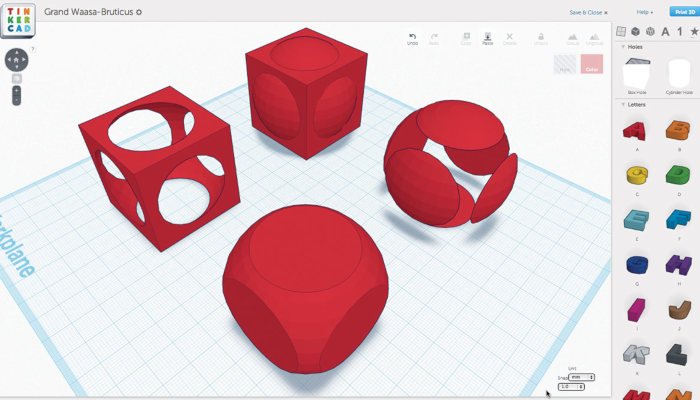
2 – FreeCAD — great free 3D printer design software
- Price: Free — Download it here
- Type: Downloadable program
- Skill level: Intermediate
Pros
Easy to use.
Open-source.
Multiple options for exporting files.
Cons
Not beginner-friendly.
A free and open-source tool for creating 3D printing files, FreeCAD offers more depth and complexity than TinkerCAD, for those with some 3D design experience looking for a step up.
Heavily adopted in architecture, rapid prototyping for product design, and especially in mechanical engineering, FreeCAD has everything you need to create great prototypes, vehicle models and other fun projects.
You have far more control over the types of shapes and geometries with FreeCAD, such as in the advanced creation of curves and boundaries. Additionally, you can draw a 2D base for your eventual 3D model using their Sketcher Workbench tool, and use that blueprint to then build up your 3D design.
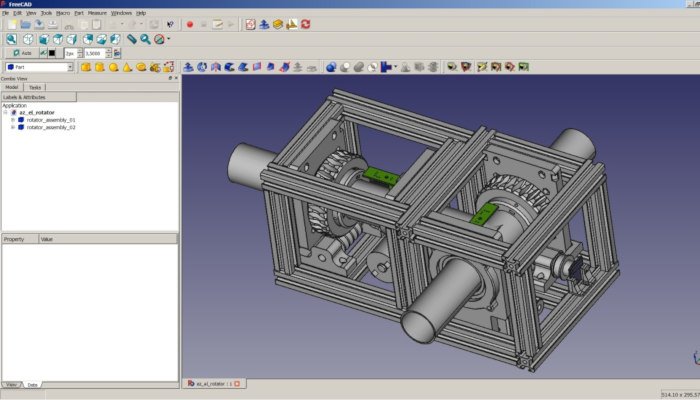
3 – Blender — most advanced 3D printer modeling software (and it’s free!)
- Price: Free — Available here
- Type: Downloadable program
- Skill level: Advanced
Pros
Huge active community.
Integrated game engine.
Comes with video editing capabilities.
Cons
Steep learning curve.
Like FreeCAD, Blender is a free and open source 3D printer modeling software tool, with a huge community committed to sharing their creations as well as coding new features that enhance Blender’s uses and offering.
Blender is a tool with huge depth; its features are not constrained to just 3D modeling, but include film and video game asset design and animation, video editing, and more. If you can traverse the steep learning curve, Blender is one of the most advanced and rewarding software tools you can ever learn.
As a 3D printer software tool, Blender offers advanced sculpting, brushing and modeling tools, with ways to intricately change a design’s surface finish with a variety of different brushes, and UV unwrapping for advanced mesh editing options.
For advanced designers looking to create extremely precise models that fit their needs, especially in character design and 3D printed miniatures, Blender is one of the most sophisticated 3D printing software tools out there. If it cost $500 for the exact same feature list, most people wouldn’t bat an eyelid.
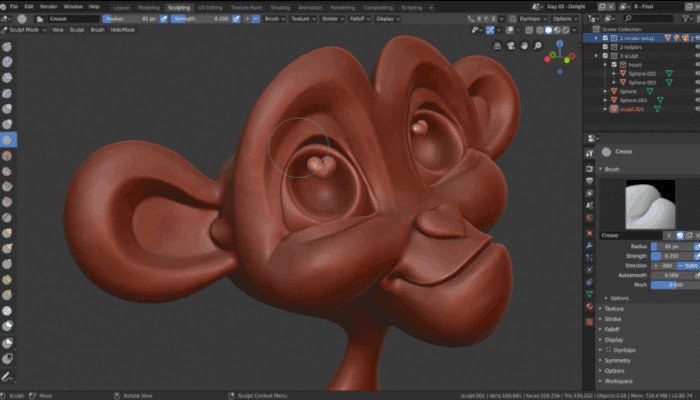
4 – Fusion 360 — best 3D printer modeling software (if you can afford it)
- Price: Free for students, or $495/year — Available on Autodesk here
- Skill level: Intermediate to Advanced
Pros
Great software for experts and educated beginners.
Cloud-based file sharing.
The modeling tools are really good and powerful.
Cons
No web-based version which is a drawback for cloud-based software.
One of the many sophisticated 3D modeling software for 3D printing offered by Autodesk, Fusion 360 is an expert program that’s still usable by an educated beginner. Fusion 360 is used extensively in designing products for rapid prototyping prior to manufacturing runs, electronics designs, mechanical engineering, and more.
One very useful aspect of Fusion 360 is the ability to collaboratively edit STL files in the cloud, so if you have a collaborator they can view and edit your designs prior to any 3D printing. If you’re both happy with your design, Fusion 360 can assess your models to locate any potential weak points that you can change and strengthen, saving you time and money from finding out any weak points later only after you’ve printing. Once finished, you can seamlessly export your finished 3D printer models as STL files and load them into a 3D slicer software program to print.
Though it comes at a cost, Autodesk have made Fusion 360 free for students on an educational license, as well as offering a free trial for all users. So, for any students looking to enhance their 3D design skills, Fusion 360 could be the ideal 3D printer modeling software for you.

5 – Rhino 6
- Price: $995 / $195 for students — Available here
- Skill level: Advanced
Pros
A more affordable option for professionals and students.
Built for intricate modeling and editing.
A wide variety of tutorials are available.
Cons
A better version of Rhino is now available.
Another premium software tool option, Rhino 6 is a more affordable tool for professionals and students, with a steep student discount to cost just $200. Built for intricate modeling and editing of even the smallest elements of parts, Rhino uses sophisticated curving, polygon meshing and surface editing tools to create perfect 3D designs.
Rhino can come in especially useful in the designing of strangely-shaped objects, using its free-form modeling features to create even the weirdest of shapes with ease. It’s very versatile, allowing for the creation of room-sized structures, as well as the smallest and most intricate jewelry designs or characters with minute and precise elements.
Some will also prefer Rhino’s payment method of a one-time, permanent license. This departs from the trend of monthly or yearly software subscriptions, making Rhino 6 a great 3D printer software option for those who want to pay once, and not pay again. The learning curve is not too steep, and Rhino themselves include a wide variety of tutorials to most of the complex tools available. Overall, it’s another good 3D printing software option for designing printable 3D models.
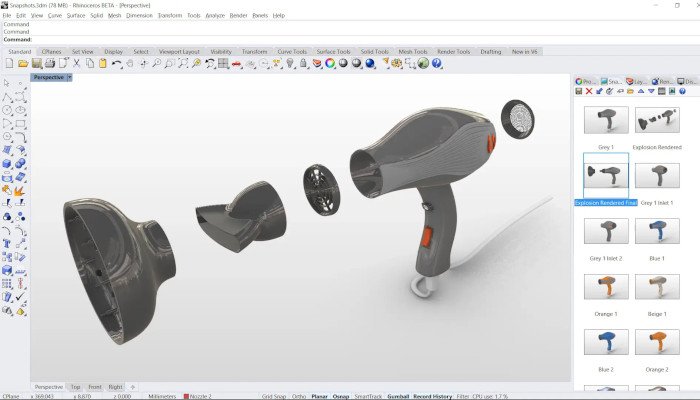
3D Printer Software Part 2: Sites to download STL files for 3D printing
This section features a few of the most well-known STL file download sites.
- We also have a full article for every STL file site, marketplace and repository, including niche STL file repositories for NASA spacecraft, medical models, and more. Make sure to check our full article on STL file sites.
6 – Thingiverse
- All files are free to download — Available here
Pros
Files are completely free to download and remix.
Easy-to-use search engine.
Cons
Has had repeated data breaches, making it not exactly safe.
The largest 3D printer model and STL file site on the web, Thingiverse is owned by Makerbot and was set up in 2008 to accommodate user-designed 3D files for Makerbot’s originally open source 3D printers.
Since then, the site has grown to host hundreds of thousands of 3D printer models; with so many quirky and fun designs available that you’ll never be left disappointed. All files are completely free to download and remix – make sure to post your edits! – and designs range from prints that will improve your productivity, hold your clothes, jewelry or stationery, and many movie, TV and video character designs hosted.
There are even designs that could potentially change your life, such as 3D printable prosthetic hand designs.
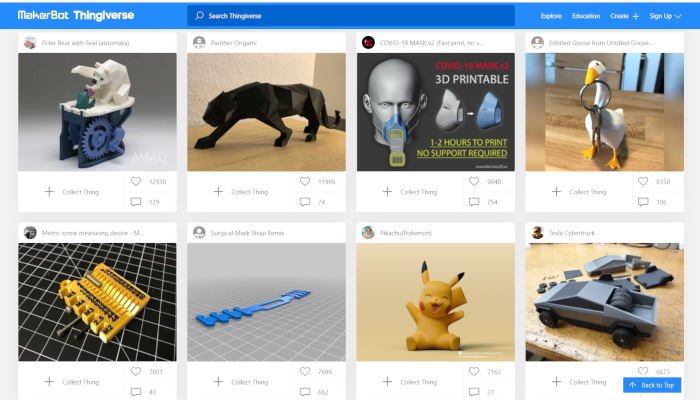
7 – Cults
- All files are free to download — Available here
Pros
A huge variety of downloadable files are available.
Encourage the use of gifs to better showcase how the 3D model will look.
Cons
Customer support is not great.
French site Cults was founded in 2014 and has grown to host over 120,000 3D printable files, receiving an incredible 17.5 million page views per month.
There are a huge variety of downloadable files available, ranging from a full-size 3D printed kayak, innovative wall storage, vases, light accessories, and even a to-scale 3D printable diplodocus skull!
An advantage of Cults is that they encourage the use of gifs and moving image to better showcase how a 3D model will look after printing, giving curious users more insight into how the model could function before committing to downloading and printing the model, saving valuable filament.
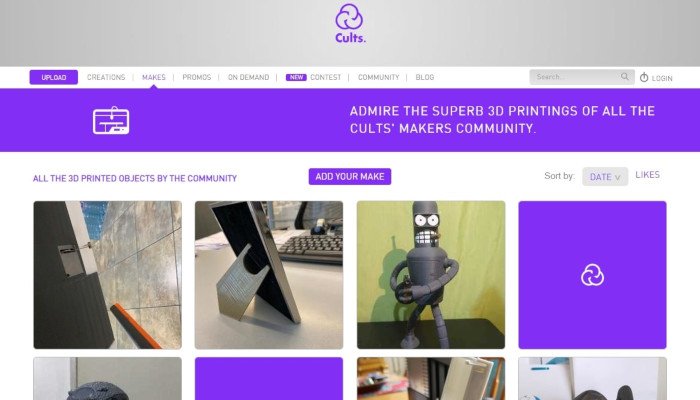
8 – Pinshape
- Free and paid 3D models — Available here
Pros
Family-friendly.
Great for teaching children how 3D design works.
Huge variety of great files and projects available.
Cons
Only accepts two file types.
Pinshape is a family-friendly STL file hosting site with mainly free 3D models, but also features premium models you’ll need to pay to download.
The friendly UX makes Pinshape a great option for families looking for a fun 3D printing project, especially those who also want to teach their children how 3D design works and basic principles of engineering.
- If you’re looking to teach your kids about 3D printing, read our ranking of the best 3D printers for kids.
Nerds will love some user-uploaded attempts to replicate Batman’s grenade launcher, the 3D printable battle scene from the Avengers, or even a Buddha status with Yoda’s head – because why not? There’s a huge variety of great files and projects here, and you also have the option to pay a small fee (usually a few dollars) for premium 3D files.
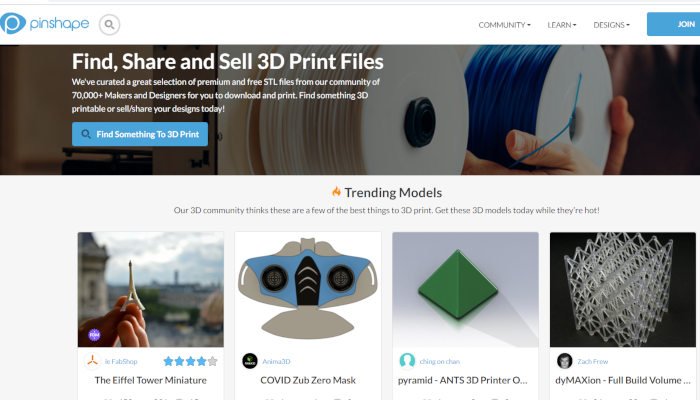
9 – MyMiniFactory
- Free and paid 3D models — Available here
Pros
Great variety of models.
Designers can make money selling their premium 3D designs.
Cons
The user interface is poorly designed.
Mixing free and paid 3D models to load up into your 3D printing software, MyMiniFactory offers a great variety of models, including an extensive range of tabletop models – I particularly loved the Pokemon chess set with Ekans for a rook, and Mewtwo for a king.
Designers can also make money selling their premium 3D designs and have their own stores for fans and customers to visit, but the majority of models are still free for casual makers.
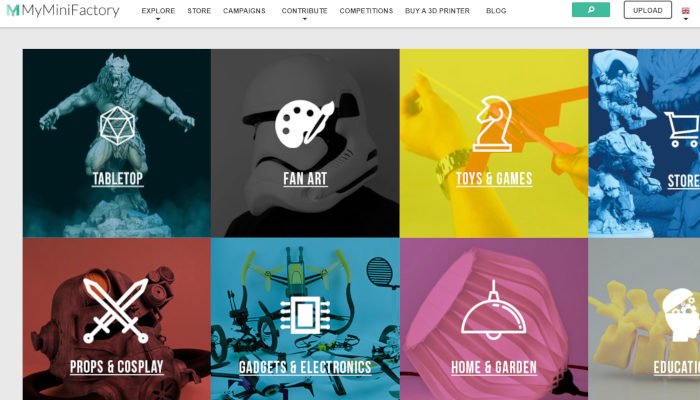
3D Printing Software Part 3: 3D Slicers
10 – Cura
- Price: Free — Available here
Pros
Powerful free and open-source slicing.
Huge active community.
One of the best free 3D slicers available.
Highly intuitive features and settings.
Cons
Unoptimized for low-end PCs.
Cura, made by 3D printing legends Ultimaker, is the most widely used 3D slicer. It’s free to download and use and open source, so you’re free to modify and improve the 3D printer software if you have the technical skills.
Though made by Ultimaker, Cura is compatible with almost any 3D printer you can ever think of, with custom pre-sets for hundreds of the most commonly used printers. Advanced users can tweak their settings according to their needs such as for supports and infills, whereas beginners can use the 3D printing software’s recommended settings for quick and easy printing.
Designed to be simple to use and integrate into your 3D printing workflow, Cura can seamlessly link with 3D CAD software tools, such as Autodesk Inventor and SolidWorks. Once you have a finished 3D model you want to print, simply choose your print settings and parameters in Cura’s Prepare stage, then preview the model in Cura’s Preview stage, which can alert you to any potential errors that would cause the print to fail, and correct them without wasting time and filament. Then once you’re ready to print, the Monitor stage allows you to remotely observe progress, including displaying estimated time remaining and the estimated amount of filament required.
Overall, it’s the most widely used, free 3D printing software for a reason, and millions of budding makers use Cura to realize their 3D dreams.
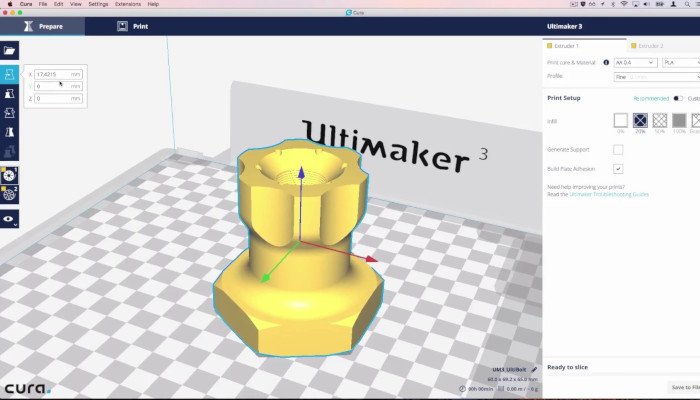
11 – Slic3r
- Price: Free — Available here
Pros
Non-profit initiative.
Open-source.
High levels of customizability and advanced features.
Cons
Less powerful engine than the likes of Cura.
Slic3r is another widely used free 3D printing software, more geared towards open source RepRap 3D printers than Cura. It’s a completely non-profit initiative, and is completely open source for other designers to adapt and improve the software – PrusaSlicer is a modified version of Slic3r.
High levels of customizability and advanced features come in this free 3D printer software package, including a wide variety of infill settings, extensive preview settings for ensuring you’re happy with your model prior to printing, and efficient dual extruder 3D printer settings for printing supports in a different material.
Known for its versatility, Slic3r can be easily integrated into OctoPrint, the 3D printing host program we discuss more later in this article. It even works with resin 3D printers as well as FDM printers, so you don’t need to use a resin 3D slicer if you have Slic3r.
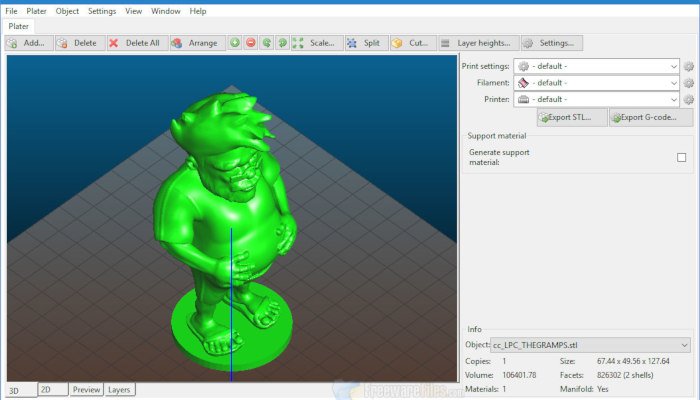
12 – PrusaSlicer
- Price: Free — Available here
Pros
User-friendly interface.
Can handle a variety of printers and filaments.
Great for beginners and more advanced users.
Cons
No option to smart hide seams in models.
Prusa 3D printers are the leading 3D printer kits, known for their immense reliability, fantastic accuracy and workhorse-like resilience. You can now even turn your Prusa machine into a color 3D printer with the Multi Material Upgrade Prusa sell.
Prusa has adapted Slic3r for Prusa printers, with an updated, more user-friendly interface that can handle a variety of different printers, and a wide range of over sixty different filaments with custom settings. You can also print on resin 3D printers, such as the Prusa SL1, using PrusaSlicer.
Beginners will appreciate the accurate automatic supports you can generate, with advanced users able to take control of more intricate support generation based on their needs. Overall, it’s a great 3D printing software and slicing tool for Prusa printers.
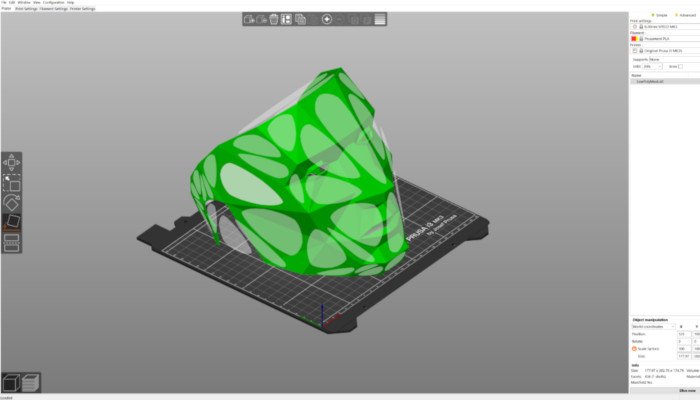
13 – Simplify3D
- Price: $149 — Available here
Pros
Offers some of the most advanced slicing and previewing features around.
Precise settings allow for customization of the thickness, layout, and material of your supports.
Cons
May be expensive for some people.
Though not a free 3D printing software tool, Simplify3D offers some of the most advanced slicing and previewing features around. It is claimed to be compatible with more printers than any other 3D printer software, and is used in STEM education, rapid prototyping, and many other hobbyist and industrial applications.
For the $150 purchase price you get to use Simplify3D on two separate computers. Your money buys you some of the most advanced support settings around, with precise settings allowing for the customization of the thickness, layout, and material of your supports, as you may be using a dual extruder 3D printer and want to print them in a soluble filament like PVA. Optimized support settings lead to better parts overall as parts keep their shape during printing, and have better surface finishes afterwards if supports can be removed more easily and without damaging the part.
You can precisely create rafts and brims, especially useful for tougher filaments like Nylon and ABS, and the previewing features can pick up things you might have missed that could cause the print to fail. Overall, if you’re spending several hundred dollars on a 3D printer, it is worth considering paying another $150 for an effective 3D printing software to ensure you print the best quality parts with optimized settings.
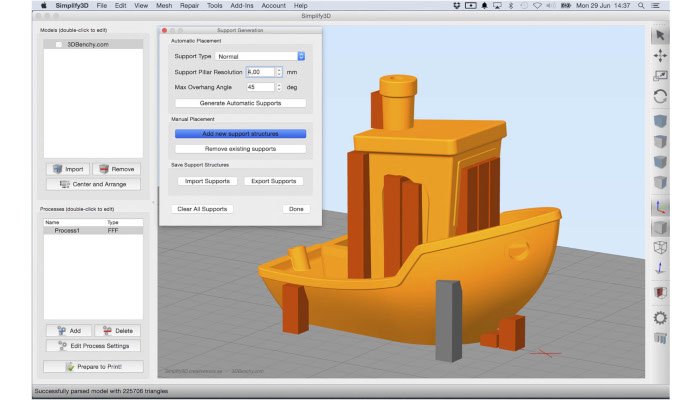
14 – Repetier-Host
- Price: Free — Available here
Pros
Can reshape, resize, and edit your imported STL files.
Open-source.
Good depth of features.
Cons
Might be too advanced for beginners.
Repetier-Host is one of a number of 3D printer software options that Repetier offer, and is a 3D slicer which lets you reshape, resize and edit your imported STL files before printing them.
Another open source 3D printing software tool, Repetier-Host is known for its effective multi-extruder support and its versatility and compatibility with such a wide range of 3D printers.
It’s not as user-friendly, and perhaps more for advanced users than beginners, but offers a number of key benefits including remote access (if you use their Repetier-Server software) to monitor printing on your smartphone or tablet on the move.
It has a good depth of features, and can handle any kind of slicing necessary for your 3D printing needs. Overall, Repetier-Host is a good 3D printing software for those with 3D printing experience, and who enjoy how well the full Repetier set of tools integrate together.

Part 4: 3D printing software for fixing STL files and making edits
15 – Meshmixer — 3D printing program for fixing files
- Price: Free — Available here
Pros
Able to edit existing models with a variety of tools.
Topological optimization makes parts lighter, saving weight and costs.
Cons
Difficult to use when developing pieces from scratch.
Owned by Autodesk, Meshmixer is a great 3D printing program which not only cleans up user-designed models to print, but can also fix any 3D scans you have recently made on your 3D scanner.
Meshmixer has a huge list of features, including editing precise elements of meshes in your models, resculpting surfaces, aligning surfaces, filling any holes in your model, detecting and repairing errors, and smoothing existing meshes, and all for free.
Key advantages include re-orienting models, for example by laying a character model on its side to minimize the overhangs when printing, therefore reducing the number of supports needed. In addition, Meshmixer lets you trim the bottom or top of your design if you don’t need it, useful if you don’t have enough filament to print the whole thing.
For industrial, or just large prints, Meshmixer works well. You can split large models into separate slices, saving each individual slice as a separate STL file to print one at a time. This is especially useful if you have a small 3D printer.

16 – MeshLab
- Price: Free — Available here
Pros
Very useful for color 3D printing.
Can hollow out models to save costs.
Very sophisticated STL editing system.
Cons
May be too advanced for beginners.
An open source 3D printing tool for cleaning up 3D scans and enhancing models prior to 3D printing, MeshLab is a very sophisticated STL editing system.
MeshLabs supports the improvement of colors in prints based on contrast, saturation and sharpness of colors – very useful for color 3D printing – as well as aligning raw 3D scans to improve them.
Additionally, with 3D printing in mind, MeshLabs can also hollow out models for those who want to save on material costs and do not mind a lower strength part, close any small holes in the piece, and flatten the bottom of your models to improve layer adhesion to the print bed during printing.
Overall, it’s a sophisticated STL and 3D file fixing and editing system, and well worth using for advanced users who crave added customization.
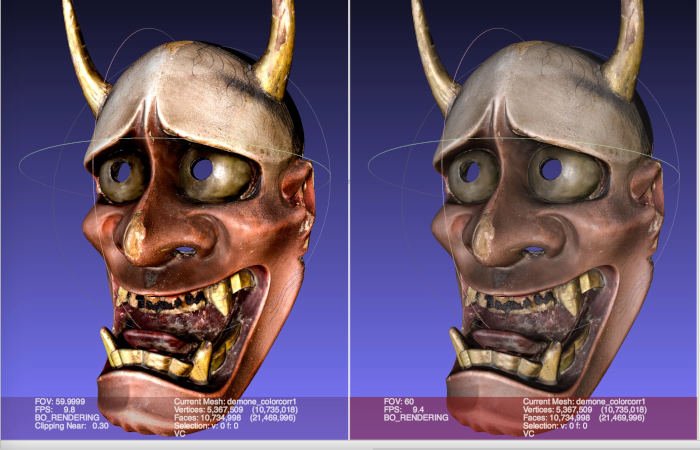
17 – Autodesk Netfabb
- Price: $30/month or $240/year for Standard, $550/month or $4,415/year for Premium — Available on Autodesk here
Pros
Great for advanced and industrial 3D printing.
Includes topology optimization features.
Cons
Not for hobbyist projects.
An Autodesk product for extremely advanced and industrial 3D printing and rapid prototyping applications, hobbyists will have no need for this level of customization, but it can be key for high-added-value, industrial applications in sectors such as automotive, medical and aerospace.
NetFabb allows you to design and edit models especially with additive manufacturing in mind, and optimize them for printing multiple parts simultaneously by packing them into the build volume of your printer most efficiently. This is especially important for saving costs in SLS 3D printers, as well as maximizing efficiency in Multi Jet Fusion.
This 3D printing software includes advanced topology optimization features, the creation of internal lattice structures for lightweight yet strong parts, and a variety of other premium features. Overall, it’s the most advanced 3D printing software for additive manufacturing, and wholly for industrial applications, rather than hobbyist projects.

Read more: the best STL editors
Part 5: 3D Printing Hosts & Remote Monitoring Software
18 – OctoPrint – best 3D printer management software
- Price: Free — Available here
Pros
Easy remote monitoring of prints on any device.
Hundreds of custom plugins are available.
Cons
Not a specialized 3D slicer.
Though OctoPrint also features 3D slicing tools, it functions as a full hosting 3D printing software system. Fully open source, and kept free by the kind donations of its supporters, OctoPrint allows for easy remote monitoring of prints on any device you can think of, from tablets to smartphones and more, and is commonly ran from a Raspberry Pi.
OctoPrint lets you see how far through your print is, the extruder temperature, estimated remaining time, and the GCODE visualizer shows you how much of your print has been completed, in real-time, without you needing to even be in the same country as your 3D printer.
If you see any clear errors are occurring, you can remotely stop the print, saving money on wasted filament. You can hook up your webcam to get actual footage of your print, and even move the print head across any axis as you need to.
You can also slice STL files for printing, but to just call OctoPrint a 3D slicer is underselling it. There are hundreds of custom plugins available to download that will enhance your experience within OctoPrint, with more technically-skilled makers able to benefit from OctoPrint’s data, remote viewing and increased control over prints.

19 – 3DPrinterOS — great 3D printer software for schools and large businesses
Pros
Also an operating system.
Can send files to hundreds of 3D printers at once.
Ideal for designers wanting to sell their files online without the risk of exposing them to being copied.
Cons
Steep learning curve.
Not just a 3D slicer, 3DPrinterOS is an operating system you can run multiple slicers and other types of 3D printing-related software on — all in the cloud.
You can use it to send files to hundreds of 3D printers at once if you run a large prototyping service, or to all the 3D printers in your school or university for certain tasks, making it a great 3D printer management software option for schools and businesses.
Moreover, it’s even ideal for 3D designers who want to sell their files online but don’t want to risk exposing them to be copied. 3DPrinterOS’ API protects the source file as it is never exposed during the sale or print ordering process — so any 3D designers getting started will find this hugely useful.
The ability to manage several 3D printers simultaneously, with readily available data reports and control of files sent to each printer, makes it a huge asset as a 3D printing software for schools.
For businesses, companies like Kodak and Cisco organize their prototyping with 3DPrinterOS as it’s such a scalable 3D printer management program.
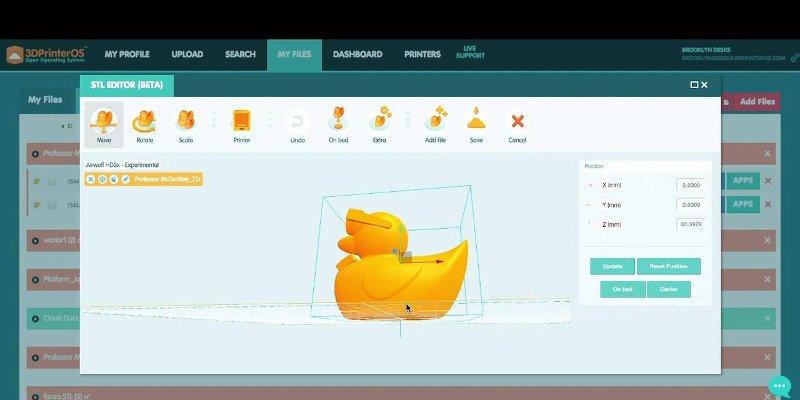


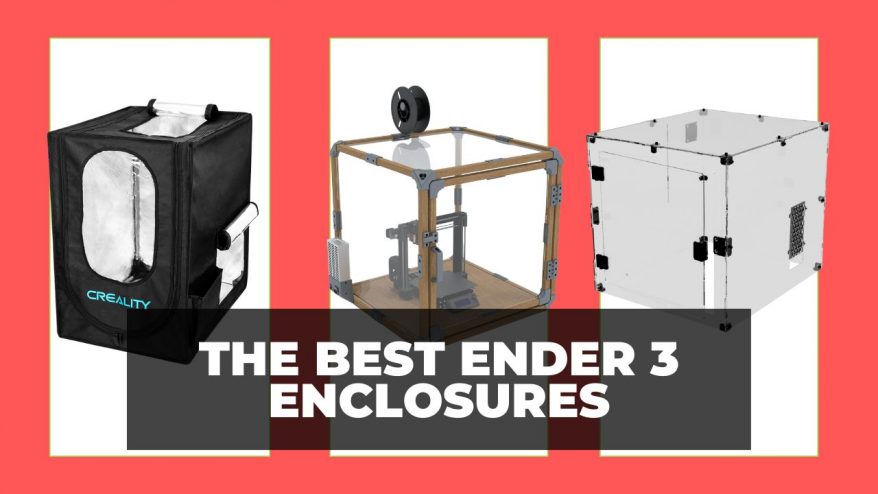

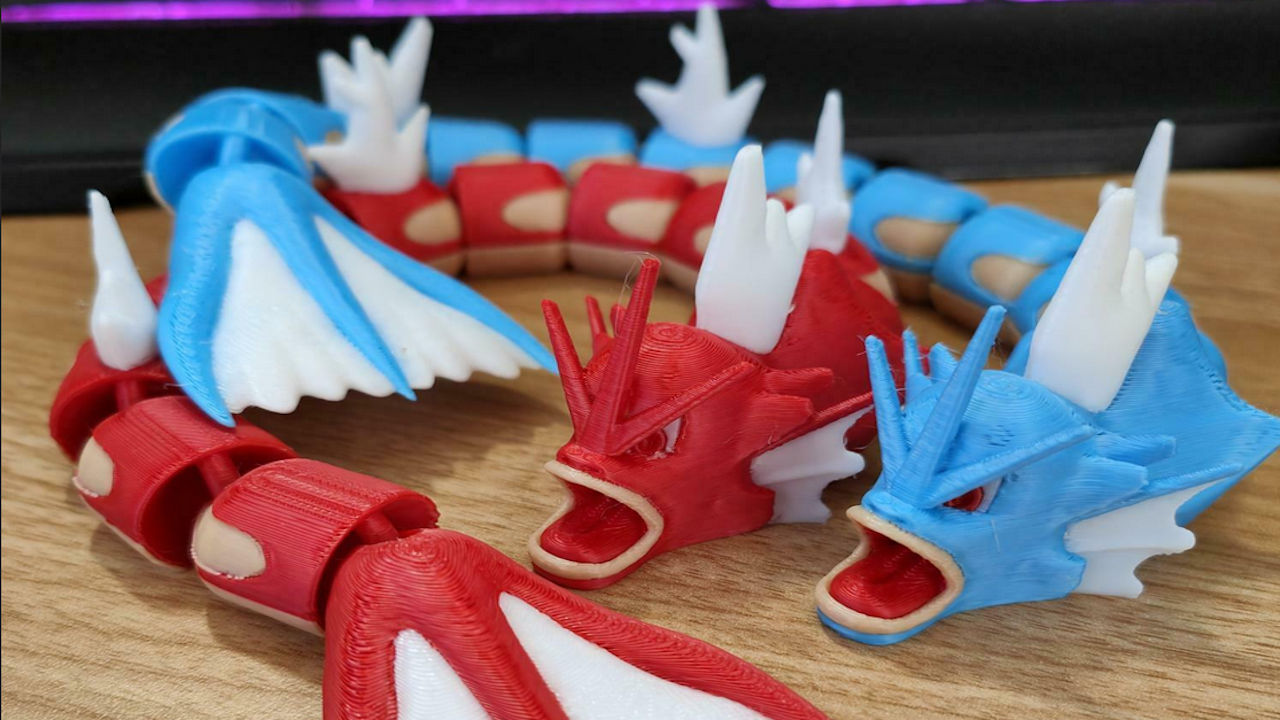







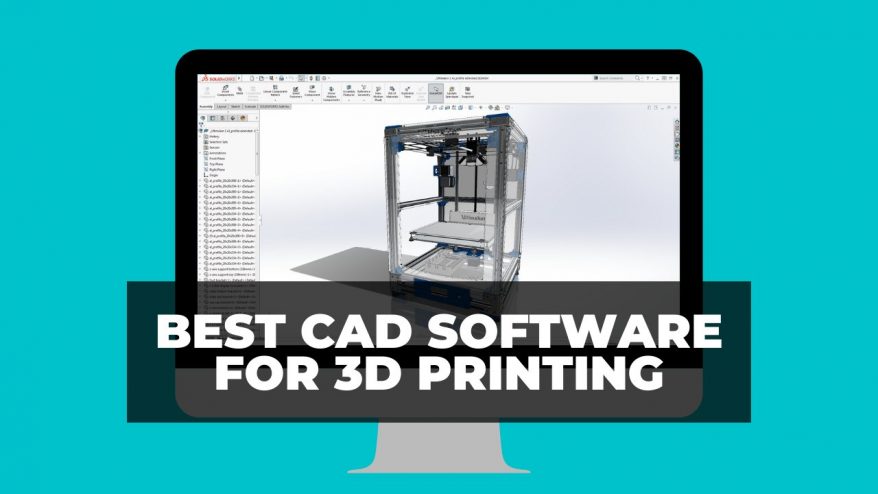








Please consider Kiri:Moto (https://grid.space/kiri/) for your next slicer recommendations or roundup. It is entirely browser-based, free, and open-source. There is nothing to install and no data is sent to the cloud. It’s been around for as long or longer than most of the other slicers and is equally capable. If you have a belt printer, it is currently the slicer with the best support for these types of devices with advanced and unique belt features.